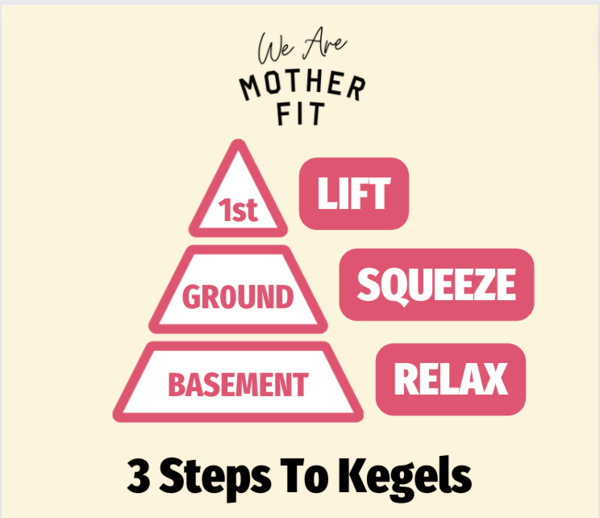
Michelle Baynham
20 Oct 2021
Performing pelvic floor exercises in pregnancy can help prevent any mishaps such as accidental leakage when you feel the urge to cough or strain. Try to embed a solid pelvic floor exercise plan into your daily routine to help control any unfortunate accidents. Pelvic floor exercises are also beneficial for both pre & postnatal mums. Building a strong pelvic floor will help in easing the delivery of your baby during childbirth, speed up the recovery process postpartum, help urinary incontinence, treat pelvic organ prolapse, and make sex better too. Everyone can benefit from doing pelvic floor exercises.
When can I start doing my pelvic floor exercises after childbirth?
You can start performing your pelvic floor exercises whenever you feel comfortable to do so post-childbirth. You may not feel up to it right now or it’s the last thing on your mind, but the overall benefits will help you so much in day to day life.
It’s perfectly safe to start exercising your pelvic floor as soon as you can. You use the muscles every time you cough and sneeze so there’s no harm in you starting a solid exercise plan to strengthen the muscle, if you feel comfortable doing so.
It can be hard to feel your pelvic floor at first, especially after going through the stresses of childbirth, which would have taken its toll on the nerves in that area as you pushed out your baby. But, even if you can’t feel too much happening, you’ll most definitely be doing your mind, body and soul some good long-term.
If you’re only just starting out doing your exercises, then don’t worry, you’ll still reap endless benefits of strengthening the pelvic area if your start today, just really try and keep at it.
Where are the pelvic floor muscles?
So, to start off, we should be laying down on our back. Now, this is going to sound weird but trust me, I want you to imagine you really need a wee and squeeze your pelvic muscles IN as much as you can to hold. You can also do the same when trying to hold in any wind. Really concentrate on drawing these muscles inwards and as tight as possible. Doing so will give you an idea of where these muscles are located and why the pelvic floor muscles are there. Another good and more practical method is to try and stop your flow of wee the next time you’re on the toilet. Try to hold this for at least a couple of seconds. If you can do this successfully then you’re using the correct muscles!
SIDE NOTE
I would NOT recommend doing this method as part of a regular exercise routine as it could cause bladder issues. It’s main purpose is to help you identify where and what muscles you need to exercise regularly to get stronger.
How to do pelvic floor exercises during pregnancy & beyond?
Before we begin, if you ever find yourself in any sort of pain when doing these exercises then make sure to stop, you should not feel any discomfort to yourself or your baby, but if you do ever come across any discomfort, stop immediately. Right, let’s workout…
Pelvic Bridge
Make sure to only perform this exercise if you are able to lie directly on your back without any discomfort.Lie on the back and bend the knees, with the feet flat on the floor about hip-width apart. Keep the arms by the sides with the palms facing down. Contract the buttocks and pelvic floor muscles, and lift the buttocks several inches off the ground. Relax the buttocks and pelvic floor muscles, and lower the buttocks to the ground.
Repeat this up to 10 times per set. Rest, then perform up to two additional sets.
Repeat this up to 10 times per set. Rest, then perform up to two additional sets.
Beginners Cat-Cow
This is more of a basic approach to the exercise which focuses more on your breathing and the action of expanding your stomach on the inhale, to then tucking your tailbone under to really activate your pelvic floor as you exhale. When this movement is mastered, you can then move onto the more advanced cat-cow.
Advanced Cat-Cow
A great exercise for not only your entire spine but also your pelvic floor. When we flex/round our spine, our tailbone tucks in thus shortening our pelvic floor muscles. Then when we extend and lengthen in the second part of the movement, our tailbone extends, which stretches our pelvic floor muscles. Really focus on the motion of the pelvic floor as you flow through the up and down motion of the movement, but also try to connect your breathing. I know it sounds like a complex exercise, but it’s such a calming, mental release when you have it mastered, while also strengthen that all-important pelvic floor.
Glute Bridge with Squeeze
You can up the demand by adding some “squeezing” with a pillow, pad or ball. This will help you work your upper abs and allowing you to connect to the entire abdominal system. The act of pressing is going to help you connect with that deep core while doing a “task.” It might seem simple, but remember we are re-training our brain, and when we start adding some layers to our task at-hand, we are asking a little more of our brain. The ball gives an excellent and subtle push back, firing up your deep abdominals. Be sure not to bear down when you push, but rather lift the pelvic floor as you push into the ball.
Kneeling Band Pull Apart
Coming up off the floor and using a pulling technique will once again engage the upper abs and hit the delts too, challenging you to keep working harder. Once again, Be sure not to bear down when you pull, but rather lift the pelvic floor as you pull the resistance band.
Ensure you exercise safely through pregnancy and beyond by joining the Mother Fit Pre & Postnatal Programs.
How regularly should I do my pelvic floor exercises?
If you’re having any leaking mishaps, then I would recommend doing a set from one of the above pelvic floor exercises at least three times a day. Try to stick to doing this every day over a 3-4 month period. The pelvic floor is a stubborn muscle to strengthen, so the overall process does take its time. When you have overcome any leaking issues, I would then suggest doing a comfortable set of pelvic floor muscle exercises once a day, every day. Nothing too challenging, just make sure you’re keeping the muscle as strong as you can, just make sure to stay on top of it and not to stop completely. Otherwise, whenever you feel a bad sneeze or cough coming on, your symptoms will come back.
When should I receive help from a healthcare professional with my pelvic floor?
If you’re still having trouble with engaging your pelvic floor or experiencing any sort of issues after your postnatal check I would highly advise seeking attention from a healthcare professional.
Issues including:
- Pain in the perineum
- Issues with defecating
- Leaking urine
- Continuously feeling downbeat and sullen
Seeking help from a women’s health physiotherapist will be able to give you a better understanding of your pelvic floor by them performing a thorough assessment of the area, while guiding you on how to perform the above exercises properly from an in-person tutorial and help treat any other problems.
Work the above exercises into a regular, daily exercise regime and let me know how you get on. For those of you who are pregnant, I would highly recommend Latched Clothing, activewear designed for pregnant women – feel free to use code MOTHERFIT for a discount.
Love Michelle x
Love Michelle x

Michelle Baynham
Share this article

